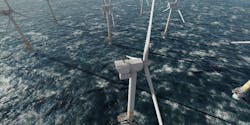DNV issues guidance on wind farm design for tropical cyclone areas
Offshore staff
HAMBURG, Germany – DNV has published a new technical note providing principles for determining site extreme wind speeds for offshore wind farms caused by tropical cyclones.
The document is published after an extensive industry collaboration to increase transparency and to reduce uncertainty in the design of wind farms in emerging offshore wind markets such as Taiwan, Japan, Korea, and the US.
Kim Sandgaard-Mørk, executive vice president for Renewables Certification at DNV, said: “Especially for emerging offshore wind markets with ambitious roadmaps, tropical cyclone loads are of critical importance. Recent events like Hurricane Ida prove that wind farms need to be designed for these extreme local environmental conditions to support the plans to develop multi-megawatt offshore wind projects.”
The technical note Site extreme wind speeds due to tropical cyclones for wind power plants is a result of a global collaborative effort, with more than 20 wind industry leaders, including OEMs, project developers, designers, and experts from/Asia Pacific, Europe, and North America.
After 18 months of work, the ACE (Alleviating Cyclone and Earthquake Challenges for Wind farms) JIP gathered enough experiences from cross-industry players to align wind farm design principles for those extreme environmental conditions.
Marcus Klose, Head of Section for Steel Structures at DNV, said: “To grow offshore wind worldwide, the need to obtain reliable extreme wind speeds became urgent, as sufficient long-term wind speed measurements to estimate extreme wind speeds are hardly available onshore, and even less for offshore sites.
“A lack of standardized approaches combined with little industry experience leads to high uncertainty on site extreme wind speeds. This substantially impacts the reliability and economic feasibility of wind farm projects. All industry stakeholders acting in emerging markets in the Asia/Pacific region and the US will benefit from the guidance we give in our technical note as it will help to minimize cost, warranty and liability risks in wind farm projects.”
09/24/2021
